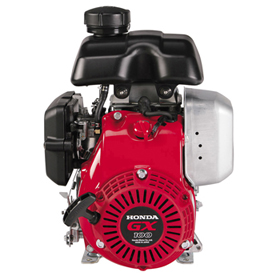 Chances are if you own any commercial-grade small engine equipment, you have at least one Honda GX Series engine. Available in horizontal and vertical shaft versions and displacements ranging from 98 to 389 cc, this series of motors can be found in just about any type of small engine equipment you can think of. Here’s what you need to know about this motor’s quirks, from starting to troubleshooting.
Chances are if you own any commercial-grade small engine equipment, you have at least one Honda GX Series engine. Available in horizontal and vertical shaft versions and displacements ranging from 98 to 389 cc, this series of motors can be found in just about any type of small engine equipment you can think of. Here’s what you need to know about this motor’s quirks, from starting to troubleshooting.
Controls
There are many variations on these models and individual pieces of equipment may leave controls on the engine or move them to a remote control center, typically on the device’s handle.
The main controls are located on the carburetor, which will be directly below the air cleaner housing. Some models will have a throttle lever at the very top, almost against the air cleaner housing. Next, on the carburetor body itself, there will be a choke lever. Below that, some models have a fuel valve.
For starting, the throttle should be set to 1/3 of the way from “Slow.” On models with the lever on the engine, move the lever left to open the throttle. The choke should be closed unless the engine is already warm, and the fuel valve should be open.
On electric start models, the engine is started by turning the key or switch to “Start.” After 5 seconds, if the engine hasn’t started, release the switch and wait 10 seconds to let the starter motor cool before trying again. If the engine won’t start, set the switch to “On” and use the recoil starter.
Checking the Oil and the Oil Alert System
The dipstick is built into the oil filler cap. To check the oil level correctly, the dipstick needs to be wiped off and then inserted into the engine without threading it back into the filler neck. When adding oil, the oil level should come to the edge of the filler neck.
Some models are equipped with Honda’s Oil Alert system. This will automatically shut off the engine if the oil level gets too low. If your motor stops abruptly, check the oil level to make sure this wasn’t the cause. On electric start models, there should be a light on the starter panel indicating the oil alert system has been triggered.
On motors with a reduction gear, the gear is in a separate case with its own oil supply. It has its own filler cap/dipstick and uses the same oil as the engine. The case should only be about half full of oil, which will be well below the top of the filler neck.
Spark Arrester
No matter the model, the muffler on your engine is designed to be used with a spark arrester where required by law. The arrester can be accessed by removing the muffler shield. The arrester itself will be held in the muffler by one screw. To clean the arrester, scrub off any deposits with a wire brush. If it has any splits or holes, it should be replaced.
Air Cleaner
There can be up to three types of air filters inside the air cleaner that need occasional cleaning:
Paper elements can be cleaned by knocking them against a hard surface to loosen dirt.
Foam elements should be washed with a mild detergent or non-flammable solvent. Once dry, dip the filter in clean motor oil and squeeze out any excess liquid.
Cyclones should be disassembled and wiped clean. Any dust inside the cleaner housing should also be wiped out before reassembly.
Propane (LPG) Powered Engines
If you have an LPG-powered version of the GX270 or GX390, there are a couple differences in operation.
Since LPG is a gas, there won’t be any visual signs of leaks. Instead, smell the area around the engine. If you detect any trace of LPG, have the fuel system repaired before starting the motor.
The choke lever increases vacuum to help pull gas into the combustion chamber. Once the engine is running, the engine will provide the necessary vacuum, and the choke can be opened. There’s no need to wait for the engine to warm up.
Use only SAE 30 weight oil designed for use with LPG engines, or a synthetic 5W-30 oil if using the engine below 32 degrees F (0 degrees C.) A mineral-based multi-weight oil may be fine in other GX motors, but it will damage your LPG model.
Getting Parts for Your GX Series Engineering
No matter what your Honda engine is connected to, you can get parts for it at www.hondalawnparts.com. We’re a certified dealer, covering both small engines and Honda power equipment including generators, water pumps, and mowers. Our advanced search engine can show you factory parts diagrams so you can see exactly what you’re ordering. We ship to both the U.S. and Canada.
